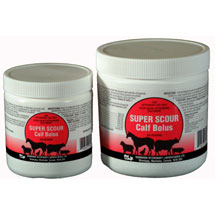 Super
Scour Bolus Super
Scour Bolus
Indications:
For use in the oral treatment and prevention of diarrhea
(scours) and entertitis of bacterial origin. Vitamin A
is included to supplement or replace loss. Atropine and
Hyoscyamine are added to id in the reduction of intestinal
hypermotility which often accompanies acute diarrhea.
Directions for Use:
Pigs & Lambs:
- 1/4 bolus daily for 3 - 4 days
if necessary
Calves & Colts:
- 1 bolus per 45 kg body weight daily for 3 - 4 days
if necessary
Caution:
- Treated animals must not be slaughtered
for use in food for at least 30 days for calves, and
14 days for pigs and lambs, after latest treatment
with this drug.
- Keep out of the reach of children.
- Do not administer to lactating dairy cattle.
Unit Size:
25 boluses and 50 boluses
Cattle Supplies: Calf scours or calf diarrhea causes more financial loss to cow-calf producers than any other disease-related problem they encounter. But calf scours is not a disease but a symptom of a disease, which can have many causes. In diarrheas, there is a discharge of more fluid than normal from the bowel, often more frequently than normal. The discharge can be white, yellow, grey or bloodstained, and is often foul smelling. Although more common in hand-reared calves, it can also occur in calves which are being suckled by their mothers. Since a calf is approximately 70 percent water at birth, loss of body fluids through diarrhea can produce rapid dehydration. Dehydration and the loss of certain electrolytes produce a change in body chemistry in the calf. Although infectious agents may be the cause of primary damage to the intestine, death from scours is usually due to loss of electrolytes, changes in body chemistry, dehydration, and change in acid-base balance rather than by invasion of an infectious agent. The infectious agent that causes scours can be a virus (BVD, Rotavirus, coronavirus), bacteria (E. coli, salmonella, Enterotoxemia) or protozoa (coccidiosis, cryptosporidium). Treatment for scours is very similar regardless of the cause. It should be directed toward correcting the dehydration, acidosis, and electrolyte loss. Antibiotic treatment can be given simultaneously with the treatment for dehydration. Dehydration can be overcome with simple fluids given by mouth early in the course of the disease. If dehydration is allowed to continue, intravenous fluid treatment becomes necessary. The age of the calf when scours begins is an important consideration in its survival. The younger the calf, the greater the chance of death. Recent research has indicated that many scour cases can be directly related to lack of colostrum intake by the newborn calf. A calf that is well mothered and consumes 1 to 2 quarts of colostrum in the first few hours after birth absorbs a higher level of antibodies and is far less susceptible to scours and other calfhood diseases.
|
THINGS GO BETTER WITH DOMINION TOP PRODUCTS
 Cattle Supplies Cattle Supplies |
 Horse Supplies Horse Supplies |
| |
|
 Poultry Supplies Poultry Supplies |
 Hog/Pig Supplies Hog/Pig Supplies |
| |
|
Click here to glance at our catalogue in Spanish.
Click here Equine Vitamin-Mineral Deficiency Chart.